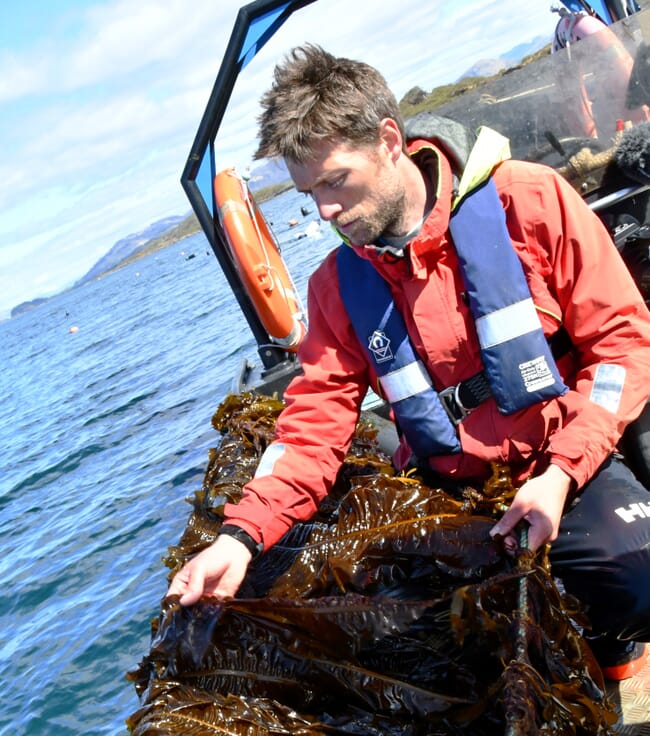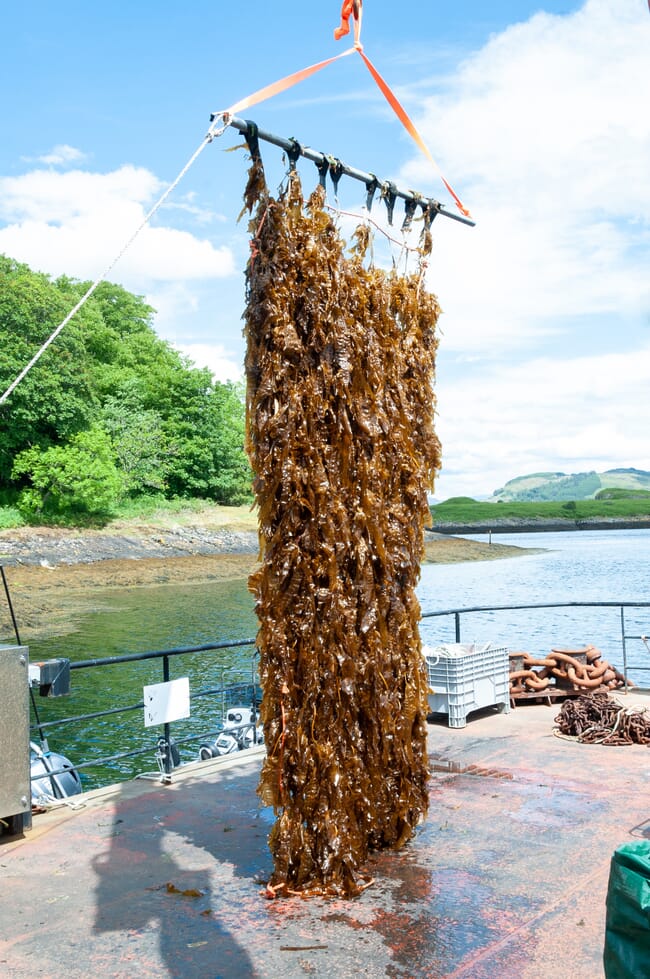
© SAMS
The UK seaweed industry is comparatively small, but the number of businesses related to seaweed in the UK has more than doubled since 2016. Currently, there are around 74 seaweed-related businesses, mainly located in England and Scotland.
The UK has 600 seaweed species, and its extensive coastlines are ideal for commercial seaweed farming and harvesting. Rockweed (Ascophyllum nodosum) is the most commonly used seaweed species by UK harvesting businesses, along with brown seaweeds like kelp and wrack, and red seaweeds like dulse and laver.
In the UK, one-third of seaweed businesses target food and drink; 19 percent target beauty; 13 percent produce nutraceuticals, and the rest other services like feed, alginate, bio packaging, and fertilisers. The 27 active seaweed producers are largely dependent on wild harvesting rather than cultivation, which is not sustainable in the long run.
Aquaculture opportunities
Farming of seaweeds is an increasing trend, and the UK government encourages the development of the sector due to its potential to contribute to ecosystem services, produce resources, and address the objectives of many policies such as the country’s 25-year Environmental Plan, national aquaculture strategies, and the UN's Sustainable Development Goals. There has been a surge of initiatives, research, and commercial ventures that showcase the potential of this emerging sector to support the local economy.
The focus of the UK government on algae-derived biofuel, alongside projects such as SeaGas, MacroFuel and BioMara, is stretching the seaweed aquaculture sector. The number of seaweed farms is increasing, with three in Scotland, four in England, one in Northern Ireland, and one in Wales. Many commercial seaweed companies are seeking to shift from wild harvest to farming seaweed, while private companies like SeaGrown, Marine Biopolymers, and Kelp Crofting are pioneering commercial-scale cultivation.
Government organisations like the Centre for Environment, Fisheries and Aquaculture Science (Cefas) and government initiatives like Seaweed Research Advisory Groups are actively working to facilitate seaweed cultivation. Similarly, research organisations have established farms – for example SAMS (Scotland), Swansea University (Wales), Queen’s University, Belfast (Northern Ireland); UHI (Shetlands), and the University of Exeter (England) are researching different cultivation methods, suitable sites, and species of seaweeds.
The Scottish Seaweed Industry Association (SSIA), and the Seaweed Alliance are functioning to support value chain, stakeholder collaboration, and educating people on seaweeds. Furthermore, Algae-UK was created to support the scientific community on seaweeds and their biotechnological applications.

© SAMS
Limits to industry growth
While seaweeds have a centuries-old tradition of use in the UK, the current production levels are struggling to meet demand and realise their full potential. At the global level, where seaweed production has experienced significant growth (from 118,000 to 358,200 tonnes between 2000 and 2019), with countries like China, Indonesia, Philippines, and Japan making substantial contributions, the UK's presence in the industry is notably absent. This policy brief explores the major challenges and issues behind the lag in this sector, which are listed below.
Legislative and regulatory issues
In the UK, legislation for aquaculture also covers seaweed regulations, which has created considerable uncertainties among investors and farmers. The marine aquaculture licence guidance mostly focuses on finfish and shellfish farming rather than seaweeds. There are restrictions on the mechanical harvesting of seaweeds at many potential locations, and small vessels, which are actually for shellfishing, are regulated for harvesting wild seaweeds. Even though sustainable harvest of wild seaweeds is possible, it is strictly regulated in many places.
Additionally, in setting up a seaweed farm, a lease permission (from The Crown Estate), and a marine licence from a respective regulatory body (Department of Environment, Marine Management Organisation, or Marine Scotland) is required. The application process for these permissions requires additional licences such as EIA, Marine Protected Areas Assessment (MPAA), Habitat Regulations Assessment (HAR), etc., which makes the process unclear, complex, and requires increased operational costs, resulting in loss of confidence amongst investors.

© SAMS
Technical and technological issues
There are several challenges in the seaweed industry of the UK related to technological knowledge gaps which are outlined here.
- Old techniques are still in practice. Traditional ways of harvesting, for instance, using sickles, hand-cutting or gathering wind-cast weeds, and small harvesting vessels are limiting the capacity. Similarly, with longline methods and nearshore farming practices, the full potential of the UK coast is not being utilised.
- The number of seaweed hatchery and seed banks is limited. At present, there is only one seaweed hatchery in the UK (Scotland), which also stores seeds of some limited species (Laminaria digitata, Saccharina latissimi, Palmaria palmata), which are insufficient to meet the demand.
- Post-harvest technology is lacking. Seaweeds should be processed as fast as possible to minimise degradation in their quality. Unfortunately, there is a lack of processing facilities, value addition technology, and skilled manpower in this field.
Environmental challenges
As seaweed aquaculture is emerging there is a wide gap in the knowledge of its impacts (positive or negative) on the environment and vice-versa. Furthermore, only a few studies are available on the environmental effects of the cultivation of seaweeds, which leaves farmers with uncertainties.
Financial and market-related issues
Although the government has shown a positive response towards seaweed farming, there is a need for funding to establish the necessary facilities, like hatcheries, seed banks, and cryobanks. Due to current UK legislation, most funding goes to either finfish or shellfish farming, and with only a small part going towards development of the seaweed sector.
The seaweed market in the UK is heavily reliant on imports from Asia (95 percent). There is a wide gap between domestic demand and supply, and the international supply creates stress on domestic production. Moreover, issues with the supply chain, labour and logistics are downgrading the market.
Disease and biosecurity
Knowledge of disease risks and biosecurity protocol is very limited and there is no law governing the standard of end products.

© SAMS
Policy recommendations
While there are significant challenges in the development of the UK seaweed industry, the policy framework outlined below is designed to elevate the industry to new heights:
- Establish a separate governmental organisation for the seaweed industry that regulates all the related sectors such as production, processing, and marketing. It should offer clear guidance and supportive regulation on setting up seaweed farms, vessel size, seasons, and methods of harvesting following environmental practices.
- Establish seed banks and seaweed hatcheries in every country in the UK, based on the farming potential of that region, and equipped with facilities like cryopreservation to ensure the preservation of valuable strains for the long term.
- Push aquaculture potential further by adopting offshore farming practices using high-tech gears, improved strains, and effective farming techniques that reduce the operational costs and cost of production.
- Establish post-harvest facilities, such as bio-refineries, based on the regional seaweed production capacity to create more valuable final products.
- Set up organisations for recording data (aquaculture production, wild harvesting), analysing disease and potential threats like invasive species, performing assessments like EIA, MPAA, HAR, and other modelling when required.
- Prioritise integrated models of farming such as integrated multi-trophic aquaculture (IMTA), in which seaweeds are farmed alongside finfish and shellfish, utilising excess nutrients and sharing risks.
- Facilitate collaboration between scientists, farmers, governmental agencies, and other stakeholders at national and international levels to improve the flow of information regarding problems, regulations, innovations, and technologies.
- Fund research organisations (like SAMS) and innovative startups (like Oceanium) for innovative ideas and products, which will highlight the UK seaweed sector in an international context.




